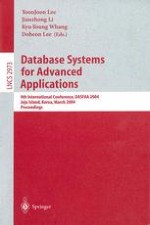2004 | Buch
Database Systems for Advanced Applications
9th International Conference, DASFAA 2004, Jeju Island, Korea, March 17-19, 2003. Proceedings,
herausgegeben von: YoonJoon Lee, Jianzhong Li, Kyu-Young Whang, Doheon Lee
Verlag: Springer Berlin Heidelberg
Buchreihe : Lecture Notes in Computer Science
Enthalten in: Professional Book Archive
